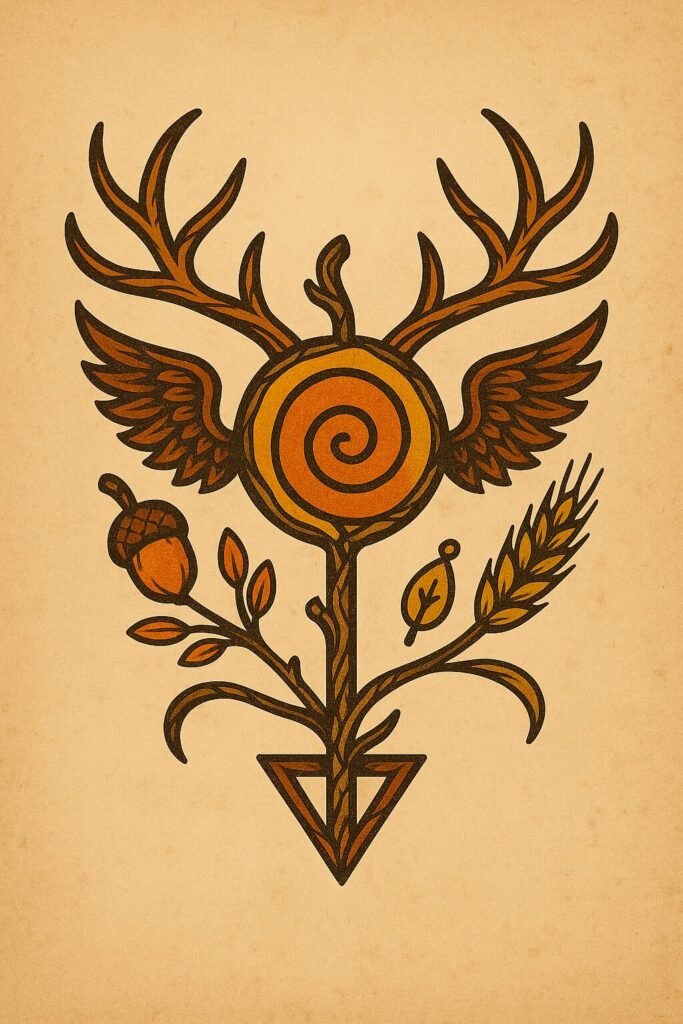The Witches’ New Year
Samhain marks the final harvest and the turning of the Wheel into its darkest quarter. Traditionally celebrated from October 31st to November 1st, Samhain is the midpoint between the Autumn Equinox (Mabon) and the Winter Solstice (Yule). For many witches, this is the most sacred sabbat of the year—a time of deep mystery, communion with the dead, and magical reflection.
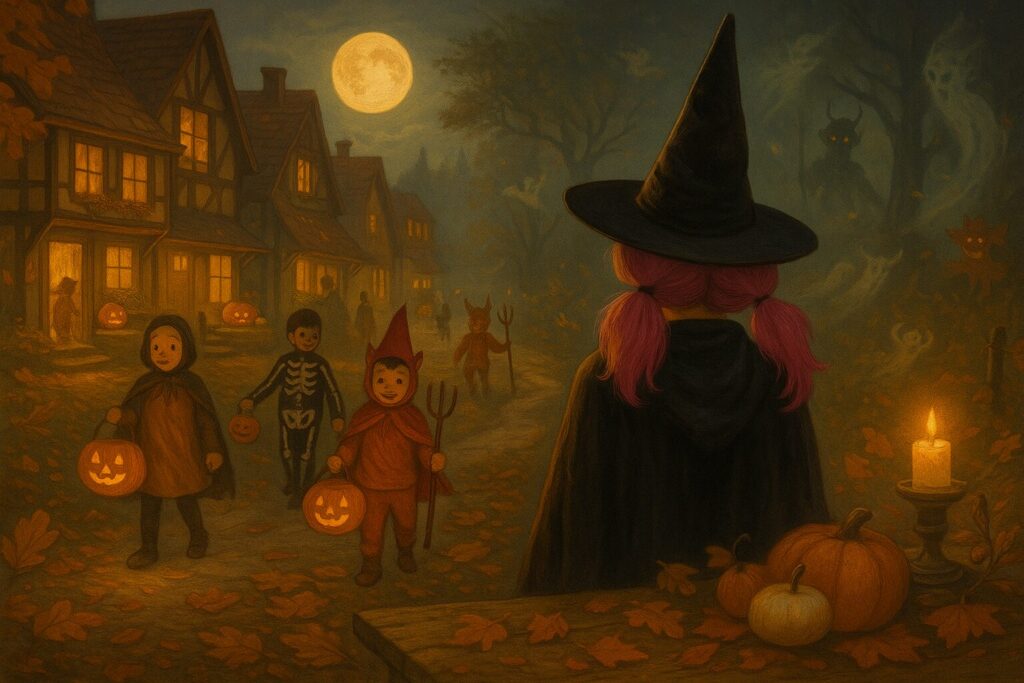
Its roots lie in ancient Celtic traditions, where Samhain was a festival of seasonal death and transformation, the thinning of the veil between worlds, and the gathering of ancestors around the hearth. It marked the end of summer’s labors and the beginning of the long night. Today, Samhain exists in two forms: the sacred and the secular. The popular holiday of Halloween—with its costumes, jack-o-lanterns, and trick-or-treating—is a descendant of Samhain, born of folklore, Christian adaptation, and modern fun. But the witch’s Samhain is different: it is still, sacred, and spell-bound. A time of listening. A time of remembering. A time of letting go.
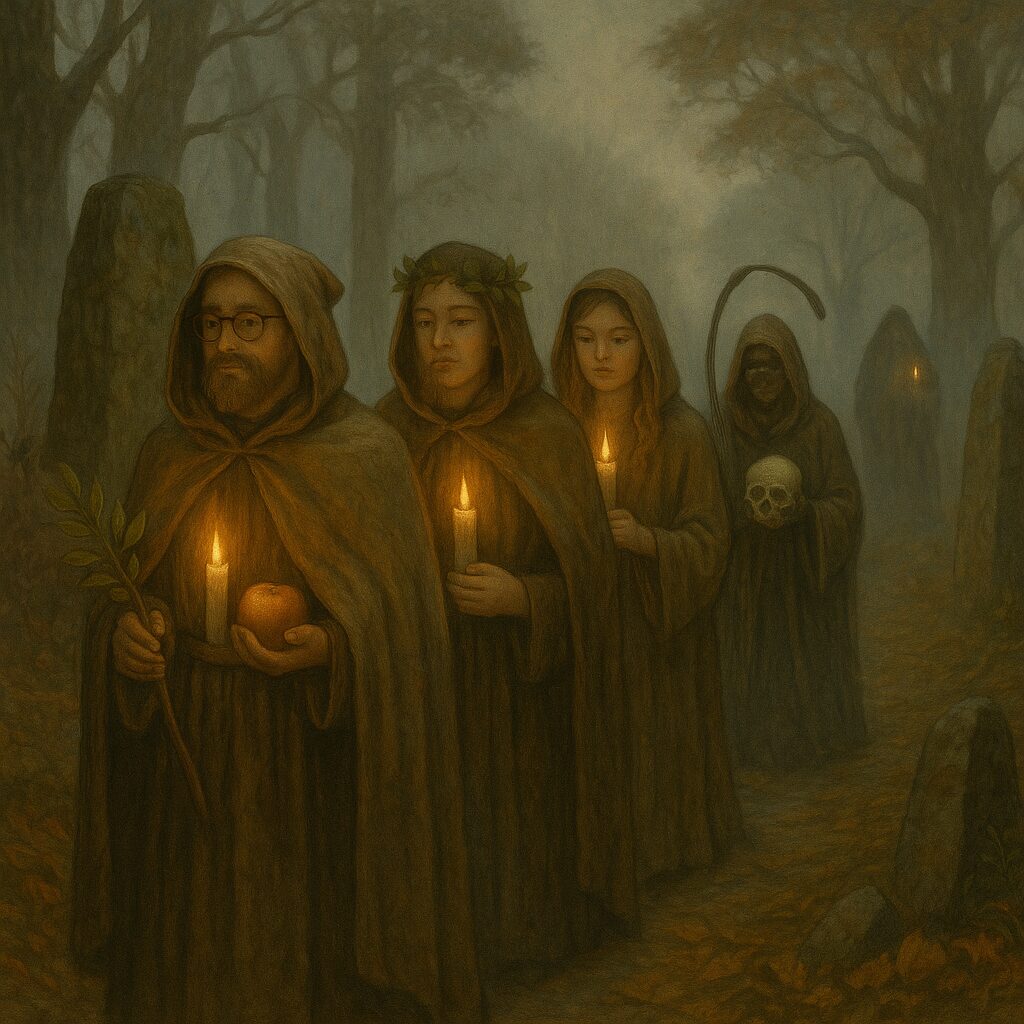
At Samhain, practitioners of witchcraft and neopagan traditions honor the liminal threshold between states of being—between life and death, light and darkness, and the fruitful activity of harvest and the inward stillness of winter. This observance is not merely a seasonal festival but a deeply symbolic rite marking closure, reflection, and the latent promise of renewal. It invites contemplation of what has passed, what yet persists, and what remains dormant, awaiting rebirth. Central to Samhain is the veneration of the Crone —an embodiment of wisdom, surrender, and purposeful descent into the shadowed aspects of the self. Alongside her presence, the ancestors, both of blood and of spirit, are invoked and remembered as guides and protectors during this spiritually potent time, believed to walk more freely when the veil between worlds thins. The festival also acknowledges the final fruits of the earth, now harvested and stored, and the metaphoric seeds we carry inward for gestation through the dark season. Samhain, therefore, is not a celebration of fear but of reverence—honoring grief as sacred, memory as magical, and death as part of an eternal cycle.

Symbolically, Samhain is replete with images and archetypes that underscore its spiritual gravity. The Crone—wise, fierce, and shadowed—is often honored in forms such as Hekate, Cerridwen, Baba Yaga, or the Morrigan, representing the final face of the Triple Goddess. Psychopomps—beings who escort souls between realms—appear frequently in myth and ritual, taking the forms of ravens, owls, deer, and deities such as Anubis and Hermes. The ancestors and the beloved dead are central to this observance, honored with offerings, silence, and sometimes ritual feasts. The final harvest is represented by apples, gourds, blackberries, and other autumnal fare—the last tangible gifts of the earth before winter’s descent. Fire, too, plays a significant role: bonfires were traditionally used to purify, protect, and guide, while the symbolic burning of bones reflected banishment and blessing. Masks and costumes, now familiar through Halloween, originated as tools of spiritual camouflage—worn not to frighten, but to harmonize with wandering spirits. Finally, the veil itself—the ephemeral boundary between the physical and the spiritual—is recognized not as a wall, but as a membrane: thin, mutable, and alive with layered meaning. Dawn and dusk are potent and the night a concern.
| Path / Tradition | Practices & Rituals | Spiritual Themes |
|---|---|---|
| Wiccan | Seasonal Sabbat rituals with Crone invocations, bonfires, scrying, and remembrance altars. Ancestor candles and shadow work ceremonies. | Death and rebirth, honoring the Goddess in her Crone aspect, balance through descent, sacred remembrance, and inner wisdom. |
| Traditional Witchcraft | Graveyard offerings, spirit flight, crossroads rituals, and ancestral feasting. Bone charms, black salt, and protective workings. | Spiritual liminality, local spirit reverence, ancestral power, boundary work, and deep place-based magic. |
| Druid / Green Witch | Rituals in sacred groves, tree offerings, chants to the fading sun, and storytelling of the ancestors. Apple rites and fire circles. | Seasonal withdrawal, the turning of the Wheel, remembrance through land, and reverence for cyclical death and rest. |
| Hearth & Kitchen Witch | Brewing cider, baking soul cakes, simmering herbs, lighting kitchen candles, and setting a dumb supper plate for the departed. | Domestic ritual as sacred space, honoring ancestors at the hearth, and nurturing spiritual connection through food and flame. |
| Dianic Witch | Crone-centered circles, rites of release, meditations on aging and wisdom, and spells for spiritual regeneration and inner vision. | Feminine power through descent, reclaiming transformation, sacred solitude, and invoking the wisdom of shadowed phases. |
| Eclectic / Hedge | Ancestor altars, tarot spreads for death and rebirth, spirit journeying, veiling, and protective fire magic. Blended traditions welcomed. | Spiritual autonomy, intuitive magic, soul thresholds, and walking between worlds with purpose and reverence. |
| Animist / Spirit Worker | Tending graves, speaking with the dead, building spirit houses, or lighting paths through candle rituals and songs to unseen beings. | Communion with nature spirits, honoring death-in-life, working through the veil, and maintaining ancestral relationships. |
There is no one way to mark this sacred turning. Samhain can be loud and joyful—or silent and solitary. It can be celebrated with community or alone in deep reflection.
Here are just a few ways to honor the season:
- Create an ancestor altar – Include photos, keepsakes, candles, and offerings.
- Hold a Dumb Supper – A silent meal where food is served for the dead. Speak with your heart, not your voice.
- Visit a graveyard or sacred place – Offer flowers, pour cider or wine, and sit in quiet communion.
- Hold a fire rite – Write what you’re ready to release on paper and burn it with reverence.
- Dress in ritual garb or robes – Especially those that reflect the Crone, death, or inner transformation.
- Decorate with intention – Gourds, leaves, bones, candles, dark cloth, seasonal herbs.
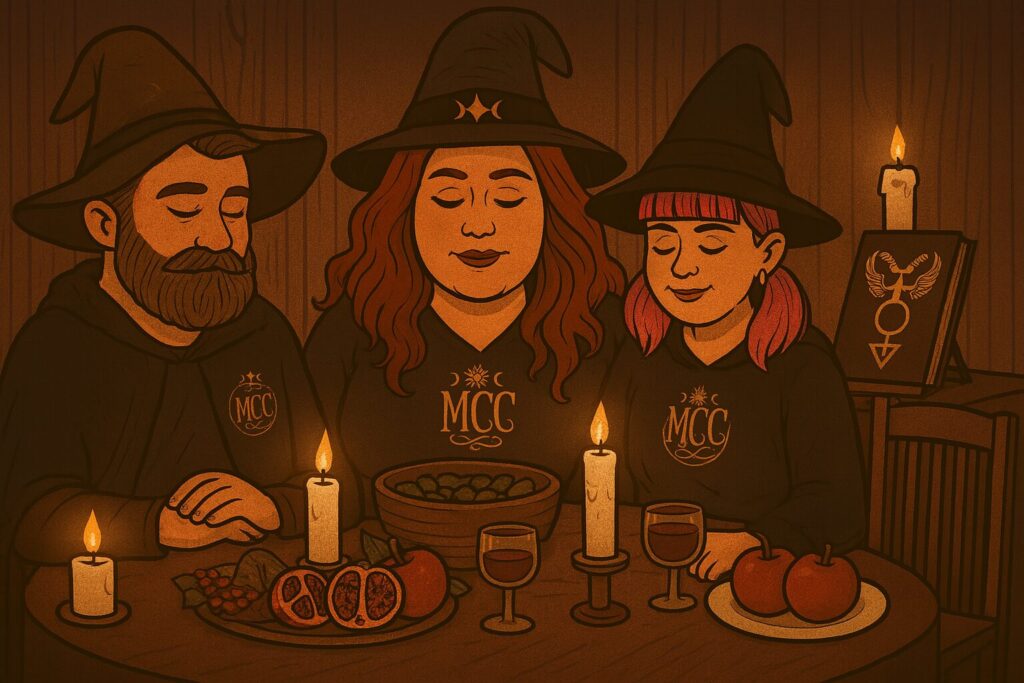
Samhain is rich with magical potential. The thinning veil allows for deep divination, ancestral communion, banishing, and shadow work. The energy of death is not fearful, but sacred—it asks us to listen, shed, and transform.
- Divination – Tarot, scrying, pendulum, or mirror work are potent now. Ask what must be laid to rest. Ask what returns.
- Shadow Work – Journal, reflect, or speak with your inner self. What are you hiding from? What part of you seeks integration?
- Protection & Warding – Use black salt, ash or rosemary bundles. Cleanse your space. Call in your guides.
- Night Magic – Work with lunar energies, especially under a dark or waning moon.
- Ancestor Magic – Speak their names. Tell their stories. Share their food. Let them teach you.
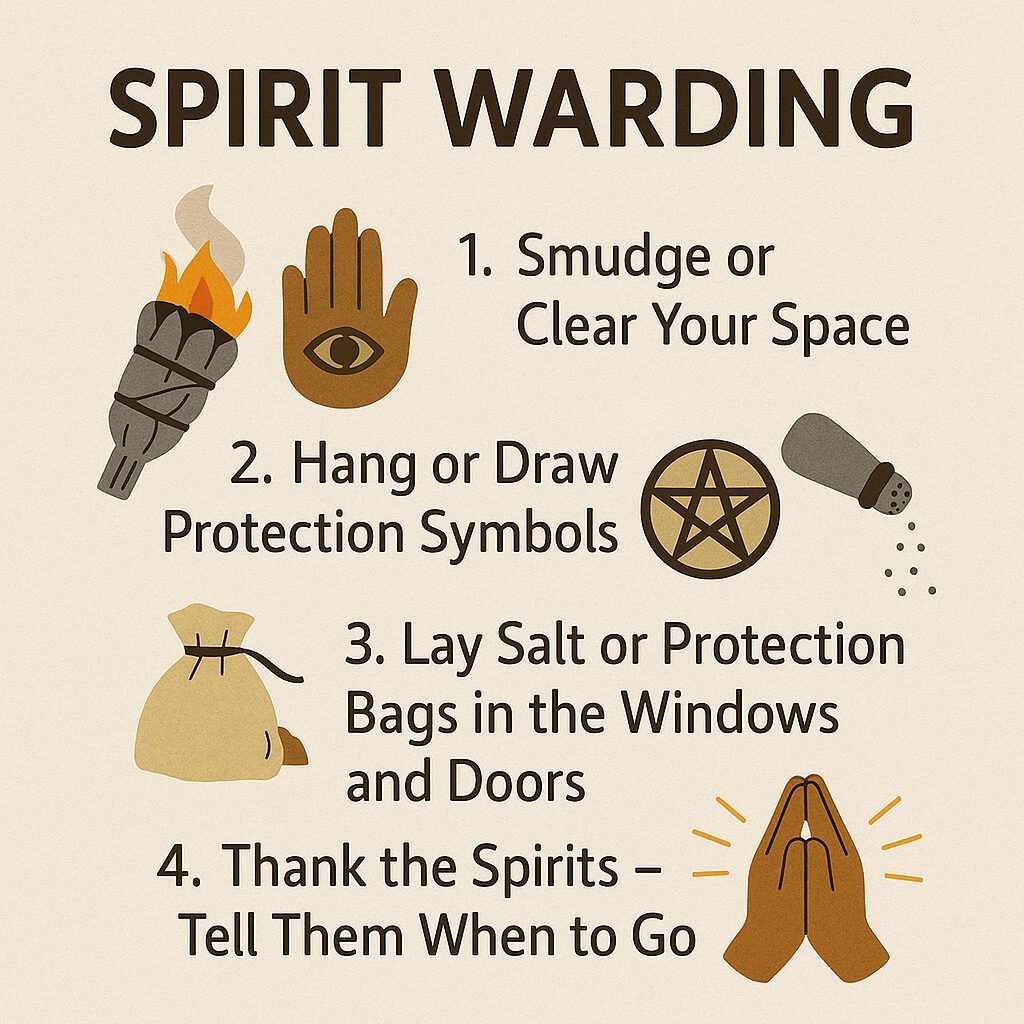
Samhain is a sacred night. A still point on the wheel. A time to walk between.
Whether you light a single candle or gather in full circle, this is a night of power. Listen to your bones. Listen to your dreams. Let the Crone lead you through the dark with her lantern, and know—deeply—that the dark is not empty. It is alive.
May your altars be full, your spirits well-fed, your circle protected, and your heart open.
